Hainanese Chicken Bibimbap: a fusion dish that will redefine your weeknight dinners! Imagine the succulent, poached perfection of Hainanese chicken, traditionally served with fragrant rice, now reimagined as a vibrant and flavorful Korean bibimbap. This isn’t just a meal; it’s a culinary adventure, blending the best of Singaporean and Korean cuisine into one unforgettable bowl.
Hainanese chicken rice boasts a rich history, originating from Hainan province in China and evolving into a beloved staple across Southeast Asia, particularly in Singapore and Malaysia. Its delicate flavors and tender chicken have captivated food lovers for generations. Bibimbap, on the other hand, is a cornerstone of Korean cuisine, a colorful medley of rice, vegetables, meat, and a fiery gochujang sauce. Combining these two iconic dishes might seem unconventional, but the result is a harmonious blend of textures and tastes that will leave you craving more.
People adore bibimbap for its customizable nature, its satisfying mix of textures, and the explosion of flavors in every bite. The addition of Hainanese chicken elevates this experience, offering a uniquely tender and flavorful protein option. This Hainanese Chicken Bibimbap recipe is not only delicious but also surprisingly easy to prepare, making it perfect for busy weeknights or impressive weekend gatherings. Get ready to embark on a culinary journey that will tantalize your taste buds and become a new family favorite!
Ingredients:
- For the Chicken:
- 1 whole chicken (about 3-4 lbs), preferably free-range
- 6 slices ginger, smashed
- 4 cloves garlic, smashed
- 4 scallions, roughly chopped
- 1 tablespoon salt
- 1 teaspoon white pepper
- Water, enough to fully submerge the chicken
- For the Rice:
- 2 cups jasmine rice, rinsed thoroughly
- 2 cups chicken broth (reserved from cooking the chicken)
- 1 inch ginger, thinly sliced
- 2 cloves garlic, minced
- 1/2 teaspoon salt
- 1 tablespoon vegetable oil
- For the Chili Sauce:
- 6 red chilies (adjust to your spice preference), seeded and roughly chopped
- 4 cloves garlic
- 1 inch ginger, roughly chopped
- 2 tablespoons rice vinegar
- 1 tablespoon sugar
- 1/2 teaspoon salt
- 2 tablespoons chicken broth (reserved from cooking the chicken)
- For the Ginger Scallion Sauce:
- 4 scallions, finely chopped
- 2 inch ginger, finely grated
- 1/4 cup vegetable oil
- 1/2 teaspoon salt
- For the Cucumber:
- 1 large cucumber, thinly sliced
- 1 tablespoon rice vinegar
- 1/2 teaspoon sugar
- Pinch of salt
- For the Bibimbap Assembly:
- 2 cups bean sprouts, blanched
- 1 carrot, julienned and lightly sautéed
- 1 bunch spinach, blanched and seasoned with sesame oil and salt
- 4 shiitake mushrooms, sliced and sautéed with soy sauce and sugar
- 4 fried eggs (optional)
- Sesame seeds, for garnish
- Nori seaweed, cut into thin strips (optional)
Preparing the Chicken:
- Prepare the Chicken: Rinse the chicken thoroughly inside and out. Pat it dry with paper towels. This helps the skin crisp up a bit later.
- Season the Chicken: In a large bowl, rub the chicken all over with salt and white pepper, including inside the cavity. Make sure every part is seasoned well.
- Infuse the Broth: In a large pot, place the smashed ginger, garlic, and chopped scallions. These aromatics will infuse the chicken and the broth with flavor.
- Submerge the Chicken: Place the chicken in the pot, breast side up. Add enough water to completely submerge the chicken. The water level is crucial for even cooking.
- Poach the Chicken: Bring the water to a gentle simmer over medium heat. Once simmering, reduce the heat to low, cover the pot, and poach the chicken for about 30-40 minutes, or until the internal temperature reaches 165°F (74°C) in the thickest part of the thigh. Use a meat thermometer to ensure accuracy. The poaching time will depend on the size of your chicken.
- Ice Bath: While the chicken is poaching, prepare an ice bath in a large bowl. This will stop the cooking process and help keep the chicken skin smooth and prevent it from becoming too soft.
- Cool the Chicken: Once the chicken is cooked, carefully remove it from the pot and immediately plunge it into the ice bath. Let it cool completely for about 15-20 minutes. This step is essential for achieving that signature Hainanese chicken texture.
- Reserve the Broth: While the chicken is cooling, strain the poaching liquid through a fine-mesh sieve. This is your flavorful chicken broth, which you’ll use for cooking the rice and making the chili sauce. Set aside.
- Prepare for Serving: Once the chicken is cooled, remove it from the ice bath and pat it dry. You can either debone the chicken and slice the meat, or chop it into serving pieces with the bone in. I prefer to debone it for easier eating in the bibimbap.
Cooking the Rice:
- Sauté Aromatics: In a medium saucepan, heat the vegetable oil over medium heat. Add the thinly sliced ginger and minced garlic and sauté for about 1 minute, until fragrant. Be careful not to burn the garlic.
- Add Rice: Add the rinsed jasmine rice to the saucepan and stir to coat it with the oil and aromatics. This helps to toast the rice slightly and enhance its flavor.
- Add Broth: Pour in the reserved chicken broth and add the salt. Bring the mixture to a boil.
- Simmer and Cook: Once boiling, reduce the heat to low, cover the saucepan, and simmer for 15-20 minutes, or until the rice is cooked through and all the liquid has been absorbed. Do not lift the lid during this time, as it will release steam and affect the cooking process.
- Fluff the Rice: After the rice is cooked, remove it from the heat and let it sit, covered, for 10 minutes. This allows the steam to redistribute and the rice to become perfectly fluffy. After 10 minutes, fluff the rice with a fork.
Making the Sauces:
Chili Sauce:
- Blend Ingredients: In a blender or food processor, combine the red chilies, garlic, ginger, rice vinegar, sugar, salt, and chicken broth.
- Blend Until Smooth: Blend until the mixture is smooth and well combined. Taste and adjust the seasoning as needed. You can add more sugar for sweetness, rice vinegar for tanginess, or chilies for heat.
- Set Aside: Transfer the chili sauce to a small bowl and set aside.
Ginger Scallion Sauce:
- Combine Ingredients: In a heatproof bowl, combine the finely chopped scallions and finely grated ginger.
- Heat the Oil: In a small saucepan, heat the vegetable oil over medium-high heat until it is very hot but not smoking.
- Pour Over Scallions and Ginger: Carefully pour the hot oil over the scallions and ginger. The mixture will sizzle.
- Season and Stir: Add the salt and stir well to combine. The hot oil will cook the scallions and ginger slightly, releasing their flavors.
- Set Aside: Set the ginger scallion sauce aside.
Preparing the Cucumber:
- Combine Ingredients: In a small bowl, combine the thinly sliced cucumber, rice vinegar, sugar, and salt.
- Mix Well: Mix well to ensure the cucumber is evenly coated with the dressing.
- Marinate: Let the cucumber marinate for at least 15 minutes, or longer if you have time. This will allow the flavors to meld and the cucumber to soften slightly.
Preparing the Bibimbap Vegetables:
- Blanch Bean Sprouts: Bring a pot of water to a boil. Add the bean sprouts and blanch for 1-2 minutes, until they are slightly softened but still crisp. Drain the bean sprouts and set aside.
- Sauté Carrots: Julienne the carrot. Heat a small amount of oil in a pan over medium heat. Sauté the carrots for a few minutes, until they are slightly softened. Set aside.
- Blanch Spinach: Bring a pot of water to a boil. Add the spinach and blanch for 30 seconds to 1 minute, until it is wilted. Drain the spinach and squeeze out any excess water. Season with sesame oil and salt. Set aside.
- Sauté Mushrooms: Slice the shiitake mushrooms. Heat a small amount of oil in a pan over medium heat. Sauté the mushrooms until they are softened and slightly browned. Season with soy sauce and sugar. Set aside.
Assembling the Hainanese Chicken Bibimbap:
- Prepare Bowls: Divide the cooked jasmine rice among four bowls.
- Arrange Toppings: Arrange the sliced Hainanese chicken, blanched bean sprouts, sautéed carrots, blanched spinach, marinated cucumber, and sautéed shiitake mushrooms around the rice in each bowl.
- Add Egg (Optional): Top each bowl with a fried egg, if desired.
- Drizzle Sauces: Drizzle the chili sauce and ginger scall
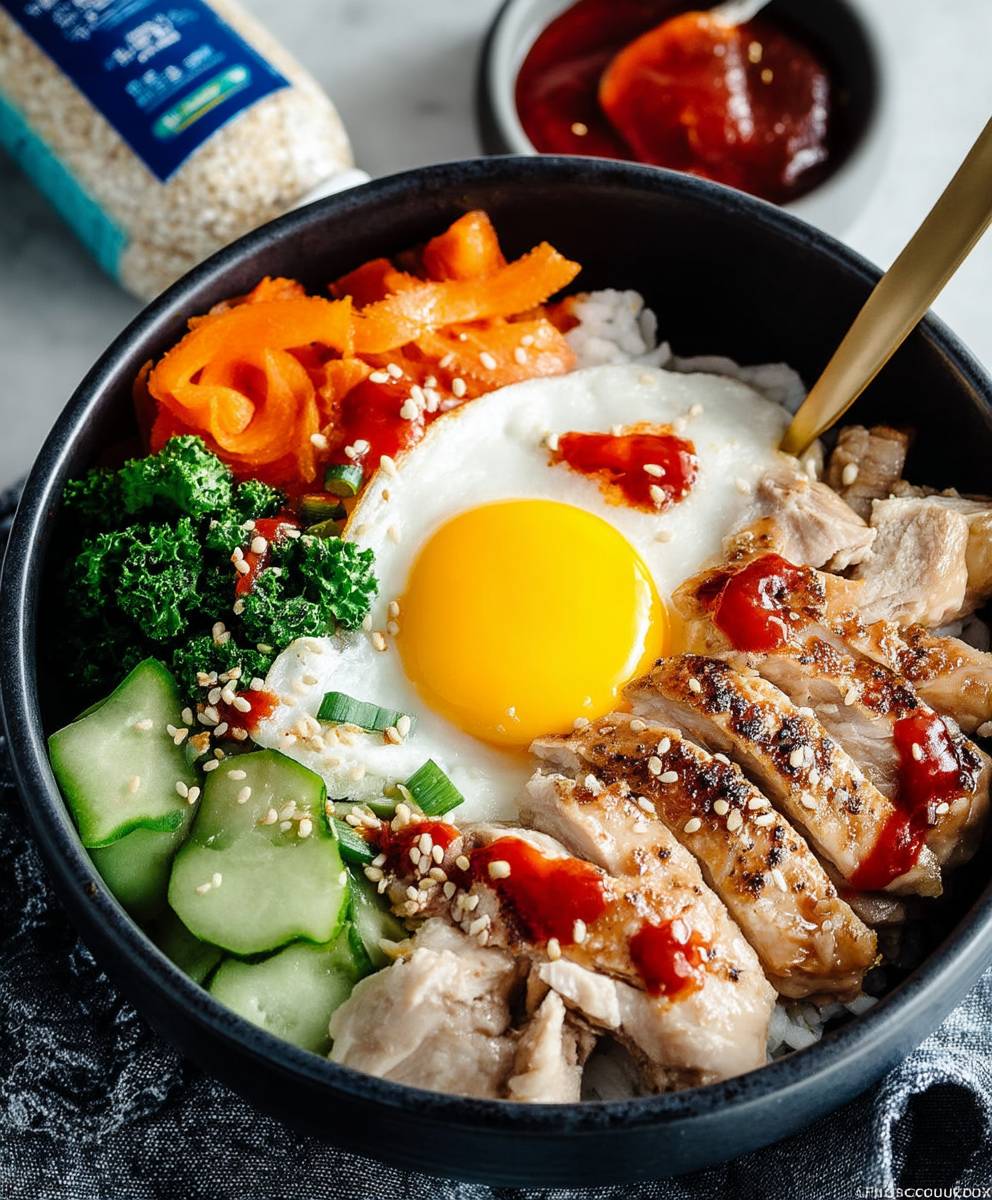
Conclusion:
This Hainanese Chicken Bibimbap isn’t just another recipe; it’s a flavor explosion waiting to happen, a culinary adventure that bridges cultures and tantalizes taste buds. I truly believe it’s a must-try for anyone looking to elevate their weeknight dinners or impress guests with something truly unique. The combination of the succulent, aromatic Hainanese chicken with the vibrant, fresh vegetables and the kick of gochujang is simply irresistible. It’s a dish that’s both comforting and exciting, familiar yet refreshingly different.
Why is this Hainanese Chicken Bibimbap a must-try? Because it’s more than just a meal; it’s an experience. It’s the perfect balance of savory, sweet, spicy, and tangy, all in one bowl. The tender chicken, infused with ginger and garlic, provides a comforting base, while the crisp vegetables add texture and freshness. And that gochujang sauce? It’s the magic ingredient that ties everything together, adding a depth of flavor that will keep you coming back for more. Plus, it’s surprisingly easy to make! Don’t let the seemingly long list of ingredients intimidate you. Most of the components can be prepped ahead of time, making it a breeze to assemble when you’re ready to eat.
Serving Suggestions and Variations:
The beauty of bibimbap lies in its versatility. Feel free to customize this recipe to your liking!
* Spice it up (or down): Adjust the amount of gochujang to control the heat level. If you’re feeling adventurous, add a drizzle of sriracha for an extra kick. For a milder flavor, use a smaller amount of gochujang or mix it with a touch of honey.
* Vegetable variations: Don’t be afraid to experiment with different vegetables. Spinach, bean sprouts, shredded carrots, and even kimchi would be fantastic additions. You can also quickly pickle some cucumbers or radishes for an extra layer of flavor.
* Protein power: While this recipe focuses on Hainanese chicken, you could easily substitute it with other proteins. Grilled tofu, thinly sliced beef, or even a fried egg would all work well.
* Rice alternatives: While short-grain rice is traditional, you can use brown rice or even quinoa for a healthier option. Just be sure to adjust the cooking time accordingly.
* Make it vegetarian/vegan: Easily adapt this recipe by using tofu instead of chicken and ensuring your gochujang is vegan-friendly (some contain fish sauce).Don’t Forget the Egg!
A perfectly cooked egg is the crowning glory of any bibimbap. I prefer a fried egg with a runny yolk, but you can also use a poached egg or even a soft-boiled egg. The yolk adds richness and creaminess to the dish, tying all the flavors together.
I’m so excited for you to try this Hainanese Chicken Bibimbap! It’s a dish that I’ve personally perfected over time, and I’m confident that you’ll love it as much as I do. It’s the perfect weeknight meal, a crowd-pleasing dish for gatherings, and a delicious way to explore new flavors.
Now, it’s your turn! Head to your kitchen, gather your ingredients, and get cooking. I can’t wait to hear about your experience. Did you make any variations? What did you think of the flavors? Share your photos and comments below! Let’s create a community of bibimbap lovers and inspire each other with our culinary creations. Happy cooking!
Hainanese Chicken Bibimbap: A Delicious Fusion Recipe
Flavorful Hainanese Chicken Bibimbap with tender poached chicken, fragrant rice cooked in chicken broth, colorful vegetables, and zesty homemade sauces.
Ingredients
- 1 whole chicken (about 3-4 lbs), preferably free-range
- 6 slices ginger, smashed
- 4 cloves garlic, smashed
- 4 scallions, roughly chopped
- 1 tablespoon salt
- 1 teaspoon white pepper
- Water, enough to fully submerge the chicken
- 2 cups jasmine rice, rinsed thoroughly
- 2 cups chicken broth (reserved from cooking the chicken)
- 1 inch ginger, thinly sliced
- 2 cloves garlic, minced
- 1/2 teaspoon salt
- 1 tablespoon vegetable oil
- 6 red chilies (adjust to your spice preference), seeded and roughly chopped
- 4 cloves garlic
- 1 inch ginger, roughly chopped
- 2 tablespoons rice vinegar
- 1 tablespoon sugar
- 1/2 teaspoon salt
- 2 tablespoons chicken broth (reserved from cooking the chicken)
- 4 scallions, finely chopped
- 2 inch ginger, finely grated
- 1/4 cup vegetable oil
- 1/2 teaspoon salt
- 1 large cucumber, thinly sliced
- 1 tablespoon rice vinegar
- 1/2 teaspoon sugar
- Pinch of salt
- 2 cups bean sprouts, blanched
- 1 carrot, julienned and lightly sautéed
- 1 bunch spinach, blanched and seasoned with sesame oil and salt
- 4 shiitake mushrooms, sliced and sautéed with soy sauce and sugar
- 4 fried eggs (optional)
- Sesame seeds, for garnish
- Nori seaweed, cut into thin strips (optional)
Instructions
- Prepare the Chicken: Rinse the chicken thoroughly inside and out. Pat it dry with paper towels.
- Season the Chicken: In a large bowl, rub the chicken all over with salt and white pepper, including inside the cavity.
- Infuse the Broth: In a large pot, place the smashed ginger, garlic, and chopped scallions.
- Submerge the Chicken: Place the chicken in the pot, breast side up. Add enough water to completely submerge the chicken.
- Poach the Chicken: Bring the water to a gentle simmer over medium heat. Reduce the heat to low, cover the pot, and poach the chicken for about 30-40 minutes, or until the internal temperature reaches 165°F (74°C) in the thickest part of the thigh.
- Ice Bath: Prepare an ice bath in a large bowl.
- Cool the Chicken: Once the chicken is cooked, carefully remove it from the pot and immediately plunge it into the ice bath. Let it cool completely for about 15-20 minutes.
- Reserve the Broth: Strain the poaching liquid through a fine-mesh sieve. Set aside.
- Prepare for Serving: Once the chicken is cooled, remove it from the ice bath and pat it dry. Debone the chicken and slice the meat, or chop it into serving pieces with the bone in.
- Sauté Aromatics: In a medium saucepan, heat the vegetable oil over medium heat. Add the thinly sliced ginger and minced garlic and sauté for about 1 minute, until fragrant.
- Add Rice: Add the rinsed jasmine rice to the saucepan and stir to coat it with the oil and aromatics.
- Add Broth: Pour in the reserved chicken broth and add the salt. Bring the mixture to a boil.
- Simmer and Cook: Once boiling, reduce the heat to low, cover the saucepan, and simmer for 15-20 minutes, or until the rice is cooked through and all the liquid has been absorbed.
- Fluff the Rice: After the rice is cooked, remove it from the heat and let it sit, covered, for 10 minutes. After 10 minutes, fluff the rice with a fork.
- Blend Ingredients: In a blender or food processor, combine the red chilies, garlic, ginger, rice vinegar, sugar, salt, and chicken broth.
- Blend Until Smooth: Blend until the mixture is smooth and well combined. Taste and adjust the seasoning as needed.
- Set Aside: Transfer the chili sauce to a small bowl and set aside.
- Combine Ingredients: In a heatproof bowl, combine the finely chopped scallions and finely grated ginger.
- Heat the Oil: In a small saucepan, heat the vegetable oil over medium-high heat until it is very hot but not smoking.
- Pour Over Scallions and Ginger: Carefully pour the hot oil over the scallions and ginger. The mixture will sizzle.
- Season and Stir: Add the salt and stir well to combine.
- Set Aside: Set the ginger scallion sauce aside.
- Combine Ingredients: In a small bowl, combine the thinly sliced cucumber, rice vinegar, sugar, and salt.
- Mix Well: Mix well to ensure the cucumber is evenly coated with the dressing.
- Marinate: Let the cucumber marinate for at least 15 minutes, or longer if you have time.
- Blanch Bean Sprouts: Bring a pot of water to a boil. Add the bean sprouts and blanch for 1-2 minutes, until they are slightly softened but still crisp. Drain the bean sprouts and set aside.
- Sauté Carrots: Julienne the carrot. Heat a small amount of oil in a pan over medium heat. Sauté the carrots for a few minutes, until they are slightly softened. Set aside.
- Blanch Spinach: Bring a pot of water to a boil. Add the spinach and blanch for 30 seconds to 1 minute, until it is wilted. Drain the spinach and squeeze out any excess water. Season with sesame oil and salt. Set aside.
- Sauté Mushrooms: Slice the shiitake mushrooms. Heat a small amount of oil in a pan over medium heat. Sauté the mushrooms until they are softened and slightly browned. Season with soy sauce and sugar. Set aside.
- Prepare Bowls: Divide the cooked jasmine rice among four bowls.
- Arrange Toppings: Arrange the sliced Hainanese chicken, blanched bean sprouts, sautéed carrots, blanched spinach, marinated cucumber, and sautéed shiitake mushrooms around the rice in each bowl.
- Add Egg (Optional): Top each bowl with a fried egg, if desired.
- Drizzle Sauces: Drizzle the chili sauce and ginger scallion sauce over the toppings.
- Garnish: Garnish with sesame seeds and nori seaweed strips (optional).
- Serve: Serve immediately and enjoy!
Notes
- Adjust the amount of chili in the chili sauce to your spice preference.
- Make sure the chicken is fully submerged in water during poaching for even cooking.
- Don’t skip the ice bath for the chicken; it’s crucial for the texture.
- Rinsing the rice is important to remove excess starch and prevent it from becoming gummy.
- You can prepare the components of this dish ahead of time and assemble it just before serving.
- Feel free to substitute or add other vegetables to the bibimbap based on your preferences.


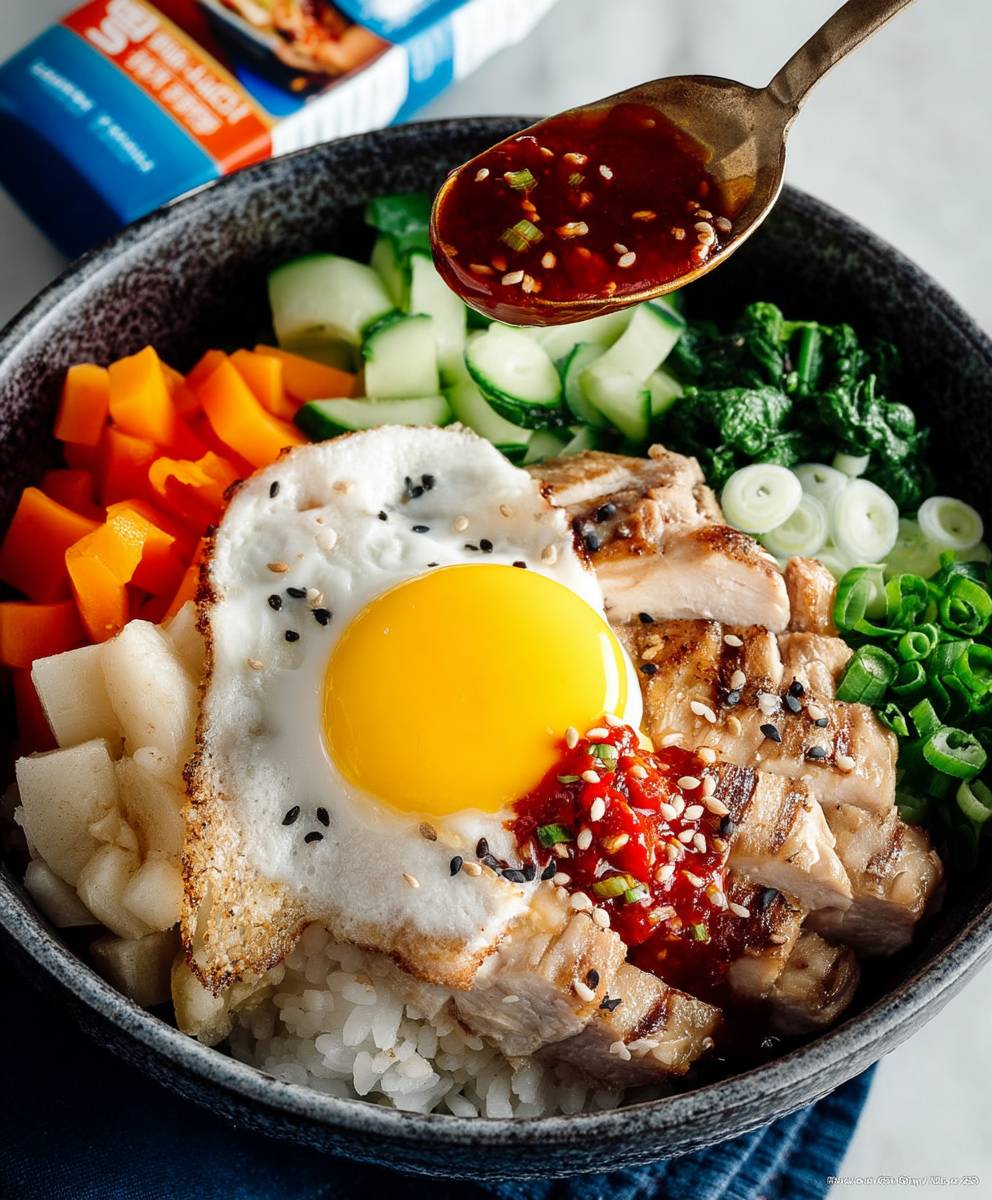
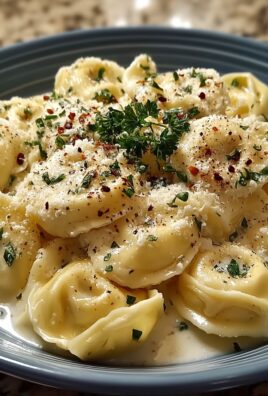
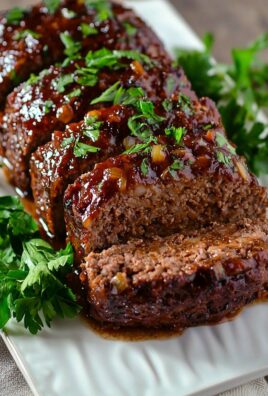
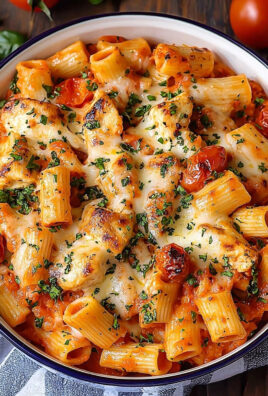
Leave a Comment